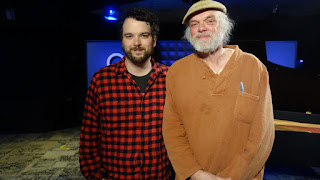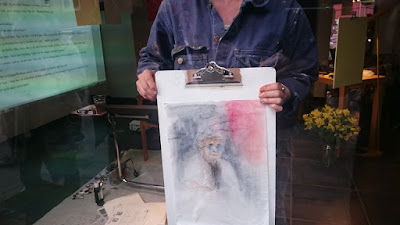 |
| Tom Power and Ted Goossen from www.cbc.ca/radio |
You can listen to the interview here:
http://www.cbc.ca/radio/q/monday-june-5-2017-jason-poo-bear-boyd-perfume-genius-and-more-1.4143013/the-joys-and-challenges-of-translating-haruki-murakami-s-work-1.4143070
Thinking about Ted Goossen brought to mind another Murakami-related article written by Stephen Snyder, professor of Japanese Studies at Middlebury College and a well-known translator of Japanese literature (but not of Murakami). It appeared a few months ago, in January 2017 and was titled "The Murakami Effect: on the Homogenizing Dangers of Easily Translated Literature."
Snyder writes about the publishing industry and the way Murakami's ("easily translated") works have been marketed globally. He compares Murakami's short story "Samsa in Love" (you can read it here on the New Yorker page) translated by Ted Goossen with Minae Mizumura's A True Novel in Juliet Winters Carpenter's translation. Mizumura's writing is given as an example of not-so-easily translated literature. The story of A True Novel is loosely based on the plot of Wuthering Heights, but it is set in post-war Japan. (It is a great book and I recommend it for a long and lazy summer reading!). "Samsa in Love" was inspired by Kafka's The Metamorphosis.
The article makes many interesting points and offers the following comments about connections between Murakami's writing and translation:
Murakami’s work begins and ends in translation. He creates fictions that are both translatable and embody translation in their themes and methods. His work moves between languages and cultures (and, perhaps particularly, into and out of English) with relative ease and fluidity, with few textual and stylistic impediments or difficult cultural contexts, but, rather, various mechanisms and textual markers that seem to invite and insist on translation as both theme and practice.
I certainly agree with this statement. One result of that technique, and of the fact that, as Snyder says, Murakami "moves between languages and cultures (and, perhaps particularly, into and out of English)" is that in their English translations Murakami's works lose some of the Western flavor they have in Japanese, which early Japanese critics used to refer to as "stinking of butter" ( バターくさい) . Somewhat paradoxically, that quality is retained in translations into other languages, where borrowings from English continue to stand out -- although perhaps not to the degree they stand out in Japanese.
You can read whole the article here:
http://lithub.com/the-murakami-effect/





